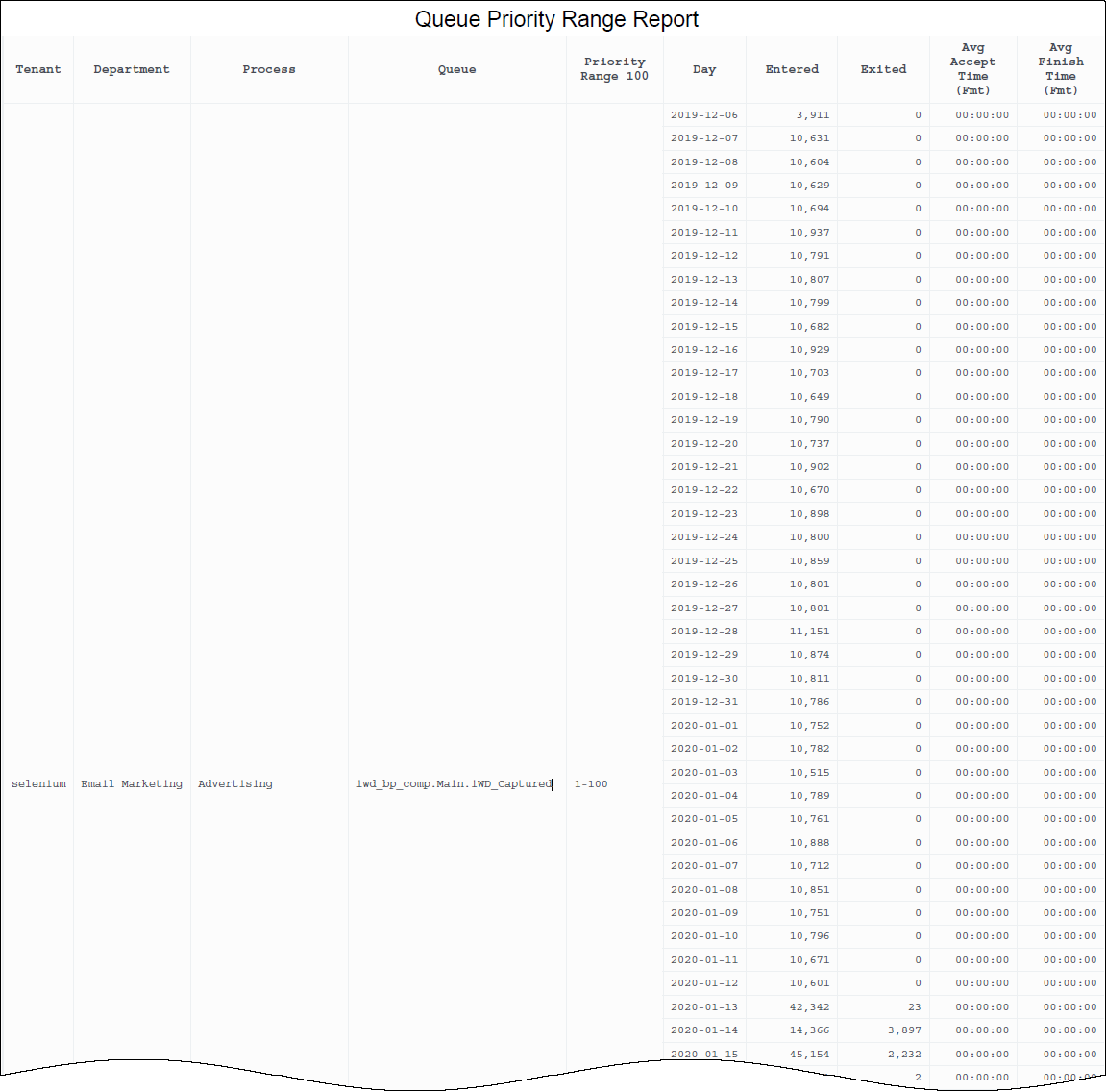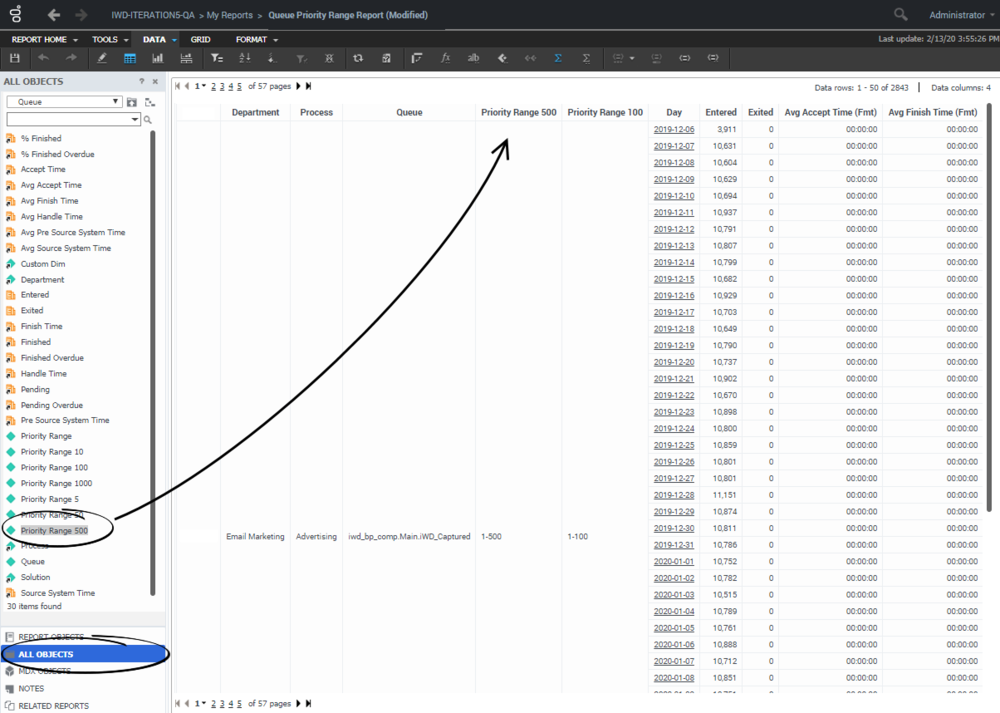Contents
Queue Priority Range Report
This page describes how you (as a technical business user) can use the (CX Insights for iWD folder) > Queue Priority Range Report to tune the priorities in the rules system and routing strategies in order to reduce average durations at processing milestones. This report is particularly useful if you manage your operations around service level-based or business outcome-based priorities.
Understanding the Queue Priority Range Report
This report breaks down the overall average that is spent to complete tasks (from inception within the presource system, to termination within iWD) into average task durations at defined milestones along a task’s routed path for each range of queue priorities.
Although this report is defined using the Priority Range attribute, you can drill along this attribute to display larger ranges in which task priorities fall.
To get a better idea of what this report looks like, view sample output from the report:
SampleQueuePriorityRangeReport.pdf
The following tables explain the prompts you can select when you generate the report, and the metrics and attributes that are represented in the report:
Prompts in the Queue Priority Range Report
| Prompt | Description |
|---|---|
| Pre-set Date Filter | Choose from the convenient list of predefined rolling time ranges, spanning one day or more, over which to run the report. |
| Start Date | Choose the first day and time from which to gather report data. |
| End Date | Choose the last day and time from which to gather report data. |
| Department | Optionally, select a department on which to focus the report. |
| Process | Optionally, select a business process on which to focus the report. |
| Queue | Optionally, select a queue on which to focus the report. |
| Tenant | Optionally, select a tenant on which to focus the report. |
Attributes in the Queue Priority Range Report
| Attribute | Description | Data Mart Table.Column |
|---|---|---|
| Tenant | Enables data within the reporting interval to be organized by tenant. | TENANT.TENANT_NAME |
| Department | Enables data to be organized by the name of the department for which iWD prioritizes and routes tasks. | DEPARTMENT.DEPARTMENT_NAME |
| Process | Enables data to be organized by the name of the business process, which is a core attribute of tasks and work items that define strategies for how to route them. | PROCESS.PROCESS_NAME |
| Queue | Enables data to be organized by the name of the interaction queue, agent workbin, agent group workbin, place workbin, or place group workbin into which tasks or work items entered. | QUEUE.QUEUE_NAME |
| Priority Range 100 | Enables data to be organized by the range in which the task’s priority falls.
Ranges are character values that have a granularity of 100—for example: 1–100, 101–200, 201–300. |
PRIORITY.PRIORITY_RANGE_100 |
| Day | Enables data within the reporting interval to be organized by a particular day within a month and year. Day values are presented in YYYY-MM-DD format. | DATE_TIME.LABEL_YYYY_MM_DD |
Metrics in the Queue Priority Range Report
| Metric | Description | Source or Calculation |
|---|---|---|
| Entered | The total number of new tasks that were distributed from this queue and were submitted to iWD during the reporting interval. | IWD_AGG_TASK_QUEUE_[Y,Q,M,W,D,H,15].ENTERED_TASK_COUNT |
| Exited | The total number of tasks that exited the queue or workbin during the reporting interval. | IWD_AGG_TASK_QUEUE_[Y,Q,M,W,D,H,15].EXITED_TASK_COUNT |
| Avg Accept Time (Fmt) | For completed tasks, the average amount of time that elapsed within the iWD system before tasks that were distributed from this queue were assigned to a resource for the first time. This metric reflects how long, on average, tasks were backlogged. | Calculated based on the value of the Accept Time and Finished metrics, where:
|
| Avg Finish Time (Fmt) | The average amount of time that elapsed before agents completed tasks that were distributed from this queue. This measure includes the time that tasks were backlogged, as well as work time. | Calculated based on the value of the Finish Time and Finished metrics, where:
|
Customizing the report
Some dashboards contain attributes representing different granularity of an attribute, such as Priority Range, or Business Value. You can change the granularity of the data shown in the report by replacing this attribute with another; this procedure uses Business Value Range in the Capture Point Business Value Report as an example.
Procedure: Changing the granularity of the report data
Purpose: Change the granularity range of an attribute. In this example, we change the Capture Point Business Value Report, which by default is configured to use the "Business Value Range 100" attribute.
Steps
- Log in with an account having Administrator privileges.
- Open and run the report. It's best to modify a copy of the report, rather than the original:
- Click Report Home > Save As.
- In the Save As editor:
- In the Save in list, choose one of the following paths:
- Shared Reports > Custom — to make the modified report accessible to other users.
- My Reports — to make the modified report accessible only to you.
- Enter a Name for the report, and optionally modify the Description.
- Click OK.
- In the Save in list, choose one of the following paths:
- In the Report Saved editor, click Run newly saved report, and answer the prompts to generate the report.
- You can now modify the report:
- From the Report Objects menu, click All Objects.
- In the All Objects hierarchy, drag the new attribute (for example Business Value Range 1000) into the report,releasing the left mouse button when over the appropriate location in the report.
- Drag the unwanted attribute (for example Business Value Range 100) out of the report grid.
- From the Report Objects menu, click All Objects.
- Click Report Home > Save. Rerun the report to verify the results.


